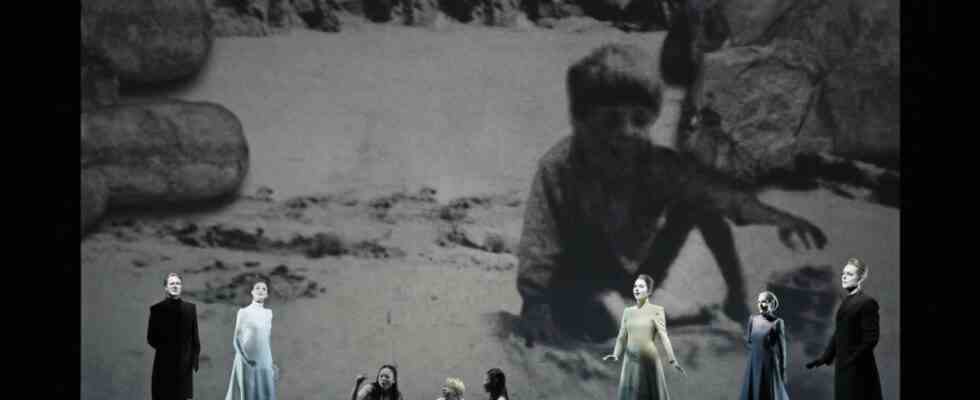No limit is correct, says Stephen Hawking in Robert Wilson’s new play. That’s actually meant to be physical and philosophical, but in this case it also applies to the director’s work. The last great formalist of the theater, who for 50 years has been staging abstract images and artificial speaking roles, trusting that the content will free itself from the gestures like stardust, suddenly crosses a line and appears as a serious moral admonisher. His staging “H – 100 seconds to midnight” is driven by such concrete statements that perhaps for the first time in the long design career of the Texan puppet artist, the content is really more important than the form.
Because the metaphors used by Robert Wilson on his return to Hamburg’s Thalia Theater 30 years after his famous production of “Black Rider” are about the man-made apocalypse. The title refers to the Doomsday Clock, the American science newspaper’s doomsday clock Bulletin of the Atomic Scientists. She is 100 seconds from Armageddon, the end of all forms. And this leitmotif is used by Wilson in his portrait by English astrophysicist Stephen Hawking from the poetic to the imploring. The clock will count down to doomsday this evening. Only the word “midnight” gives some hope of a new dawn for humanity, albeit not on Mother Earth. According to Hawking’s belief, the future of his species lies in space – leaving the destroyed planet behind like “a room in a sun”.
It is said that man will merge with nature. That’s not good news
The director of the theatre, Joachim Lux, returned to the role for this project, which he performed productively at the Burgtheater in Vienna, among others, before he became director in 2009. As a dramaturge and text collagist, he created Wilson’s Menetekel, which basically consists of three components: the best-selling texts by the Cambridge professor, the poems by the Lebanese artist Etel Adnan, whose pictures and words deal with the universe and the role of humans in it as well as from Walter Benjamin’s thoughts on Paul Klee’s picture “Angelus Novus”, which he interpreted as a repulsion of progress into a stormy future. The “angel of history” is looking at a “single catastrophe that is constantly piling up rubble upon rubble.”
Wilson creates spartan architectural images and cold mood lighting around the five actors, who present the dark drama of humanity not as tragedy, but as a stoic expectation of the inevitable. “Is there a God?” A voice from the off asks in many scenes. That’s the title of the first chapter of Hawking’s last book, “Brief Answers to the Big Questions.” And whoever knows that the astrophysicist, who suffered from ALS, separated from his first wife because she was convinced of his existence, knows the answer. Man has to take responsibility for the fact that he soon “merges with nature” in a different way than the romantics imagined: “for lack of love.”
Those are Etel Adnan’s words, and her lyrical devotion to the human journey into the apocalypse informs the most beautiful scenes of the evening. The artist, who was only discovered as important around ten years ago at documenta 13 and died during this joint work with Wilson at the age of 96, finds a tone of affection in all her sadness about the stupidity of the male-dominated world. Her openness to life brings comfort to Wilson’s dark evening, such as passages from her poem “The Arab Apocalypse” about suns of different colors. And Hawking’s explanations of the world from the physical perspective were always carried out with humor and optimism.
Hawking’s vision of humanity’s future: finding other planets to live on
But even this incentive to be positive turns into darkly sarcastic in Wilson’s production. In the central scene, in which Jens Harzer, Barbara Nuss, Tim Porath, Pauline Renévier and Marina Galic count down the 100 seconds to the end of the world as white-painted automatons, Hawking’s vision of the future of mankind is woven in: that it will find other planets to live on. And in this scenario that seems like the typical “after me the deluge” mentality, with which the consumption machines ignore the consequences of their habits.
Plays the central role in Wilson’s two-hour montage of scenes Jens Harzer. Stylized like a Ted from the optimistic era of post-war capitalism, this Stephen Hawking spirit shifts into various artificial emotional segments. He talks pensively about the astonishment of the researcher before infinity, fantasizes about the similarity between angel and astronaut, he celebrates everyday life at home in robot mechanics, and he is also allowed to tell bad jokes. Despite everything, he remains a being without character, which is filled with texts like a hard drive.
What Hawking says also applies to the end of the world: No limit is correct
Its antithesis is Barbara Nuts, who philosophizes about the moon in her haunting reductionism. Although she hardly moves like all the actors in this static production, she is touching with her melancholy openness to the beauty of things. Sitting at the edge of the stage in the spot, this serious philosopher of mindfulness arouses the ideological opposition with just her voice. Those who value appearances more than their explanations are not concerned with precision and efficiency, but with participation and kindness.
Between these contrastingly tempered figures, Wilson has left room for other actors. Famed choreographer Lucinda Childs, with whom Wilson collaborated from his early days in New York, choreographs three minimalist ballets featuring elves, rocks and cackling children to music by Philip Glass, another longtime collaborator of Wilson’s. And in this multifaceted cooperation of independent forms, there remains enough unexplained to perhaps not experience the great mystery of the human future as clearly as the passage of time on the doomsday clock suggests. It also applies to the prophecies of the end of the world as inevitable: no limit is correct.

